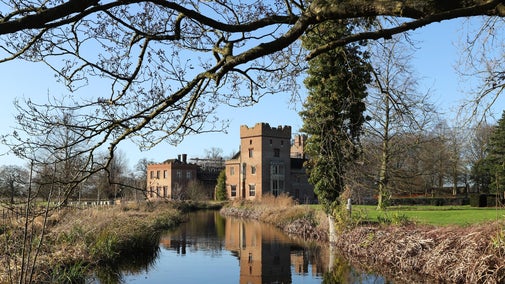
Discover more at Compton Bay and Downs
Find out how to get to Compton Bay and Downs, where to park, the things to see and do and more.

The land at Dunsbury is a crucial part of our coastal nature conservation management on the Isle of Wight and our ongoing aims to farm the land in a way that allows wildlife to return and thrive. There's a network of paths from which you can see how the landscape and wildlife is changing, as well as enjoy butterfly and birdwatching.
We took on care of Dunsbury Farm in 2015. Since then, we've set about evolving it from intensive farming to a wildlife-rich landscape that’s farmed in a more sustainable way.
The 165-hectare (407-acre) site will become a mix of coastal grassland with scattered shrub and woodland and there'll also be areas of wet grassland, fen and naturally active undercliff.

The land on which arable farming once took place consists of very light sandy and clay soils on slopes leading down to the sea. These suffered from considerable soil loss when it rained and the rapid flow of silt-laden water, in straight ditches, gushed out of the pipe in Shippards Chine.
We started by sowing low-input cereals to create a green cover and reduce the levels of artificial nutrients. Since then, we’ve allowed all of the arable land to naturally change to grassland to help stabilise the soil and slow down the rainwater runoff.
The grasses and other plants that have become established have grown from seeds already in the soil or have spread from surrounding areas. The first plants that emerged, such as bristly ox-tongue, teasel and beaked hawksbeard, are quite tall with deep roots which help restore the soil structure following compaction from arable machinery. Since 2022 we have started to see cliff-top flowers such as thrift and wild carrot, amongst other smaller flowers, growing in the fields. This is the first indication that a more species-rich grassland habitat is becoming established.
The sandstone ridge was grazed tightly by sheep which resulted in few plants being able to flower and self-seed. We now graze this grassland with a small group of cattle which enables the existing grassland to flourish to its full potential.

Over time, the areas of scattered scrub and woodland will develop and provide a more varied landscape and habitat for farmland wildlife such as voles, mice, kestrels, linnets, butterflies and other insects.
Neighbouring Compton Farm already plays an important part in the management of Compton Down and parts of the coast. Sensitive wildlife-friendly farming of Dunsbury is allowing the wildlife on Compton Farm to spread out and become more resilient.
All this is leading to an increase in birds. Already, a wide variety of raptors (including the occasional endangered short-eared owl) have been spotted hunting for the small mammals that are colonising the naturally restoring arable fields. And the hope is that more skylarks, stonechats, yellowhammers and swallows will flock to the area too.
What’s next?
In 2024 we started grazing the former arable fields with cattle from Compton Farm. This will create a more varied habitat with a mixture of open grassland and patches of developing scrub and woodland. The cattle also distribute wildflower seed through their coats and dung and encourage insects (and the animals that feed on them) through their dung too.
We’re also planning to change the deep arable ditches, and a steep sided reservoir, to allow water to act more naturally and create areas of wet grassland and fen for a wider variety of plants and insects to flourish. These plans are still in development.

Find out how to get to Compton Bay and Downs, where to park, the things to see and do and more.
Discover one of the Isle of Wight’s favourite spots with plenty of space to explore, search for fossils, spot local wildlife, surf, cycle and ride your horse.

Go fossil hunting and discover history on a gigantic scale, with dinosaur footprints, fossilised oyster shells, ammonites, flint made from ancient sponges and modern-day shipwrecks

Read our view regarding the future of the Military Road and how we’ll judge any impact on the land and nature we look after.

We believe that nature, beauty and history are for everyone. That’s why we’re supporting wildlife, protecting historic sites and more. Find out about our work.
